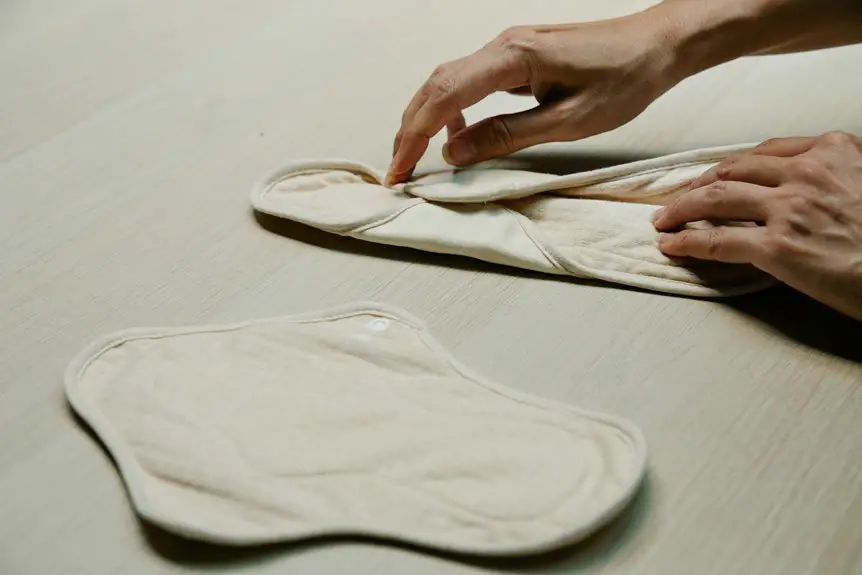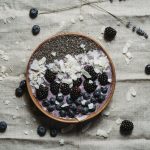To effectively tackle fabric odors, start by identifying their sources, like sweat or food spills. Natural remedies work wonders—try baking soda to absorb smells or vinegar to neutralize them. For a quicker fix, consider commercial fabric fresheners with non-toxic ingredients. Remember, different fabrics react differently to treatments, so choose wisely. You can maintain freshness through regular washing and ventilation. Find out more about specific solutions tailored to your fabrics and their unique needs.
Table of Contents
Key Takeaways
- Baking soda effectively absorbs odors; sprinkle it on fabric, let it sit, and vacuum for best results.
- Vinegar mixed with water neutralizes odors; mist on fabric and allow to air dry for odor removal.
- Activated charcoal traps odors and moisture; place it in breathable bags near fabric to enhance freshness.
- Essential oils can mask unpleasant smells; add a few drops to cotton balls and store them with fabrics.
- Choose natural or non-toxic commercial fabric fresheners for effective odor neutralization without harsh chemicals.
Understanding Fabric Odors
When you notice unpleasant odors lingering in your fabrics, it’s essential to understand what causes these issues. Fabrics can absorb odors from various sources, including sweat, food spills, and pet dander. These smells can become trapped within the fibers, making them difficult to eliminate.
The materials themselves also play a role; natural fibers like cotton tend to hold odors more than synthetic ones. Additionally, improper washing methods can contribute to the problem, as residue from detergents or fabric softeners may cling to your clothes.
Common Sources of Odors in Fabrics
Although various factors contribute to fabric odors, some common sources stand out. Identifying these sources can help you tackle the problem effectively.
Here are a few culprits you might encounter:
- Sweat and body oils: Over time, these natural substances can build up, leading to unpleasant smells.
- Food spills: Accidental spills from meals or snacks can seep into fabrics, causing odors that linger if not treated promptly.
- Pet accidents: If you have pets, their accidents can create strong, lasting odors in fabrics, making it essential to address them quickly.
Natural Remedies for Odor Absorption
After pinpointing the common sources of odors in fabrics, it’s time to explore natural remedies that can effectively absorb and neutralize those unpleasant smells.
Baking soda’s a fantastic option; just sprinkle it on the fabric, let it sit for a few hours, and then vacuum it up.
Vinegar is another powerhouse—mix equal parts vinegar and water in a spray bottle, lightly mist the fabric, and let it air dry.
Activated charcoal works wonders too; place it in a breathable bag near the odor source.
For a revitalizing scent, you can also use essential oils—add a few drops to a cotton ball and tuck it into your fabric storage.
These natural solutions are safe, easy, and budget-friendly!
Commercial Fabric Fresheners: What to Look For
What should you consider when choosing a commercial fabric freshener? You want a product that not only masks odors but also neutralizes them effectively.
Here are some factors to keep in mind:
When selecting a commercial fabric freshener, consider key factors like ingredients, scent strength, and versatility.
- Ingredients: Look for natural or non-toxic components to avoid harsh chemicals.
- Scent Strength: Choose a fragrance that suits your preference, but be cautious of overpowering scents that can irritate.
- Versatility: Opt for a freshener that works on various fabrics, from upholstery to clothing.
Evaluating the Effectiveness of Odor Absorbers
When you’re choosing an odor absorber, it’s important to understand the different types available and how they work.
You should also consider the scientific evidence backing their effectiveness, as studies can provide insights into what really neutralizes odors.
Let’s explore how these factors play a role in selecting the best option for your needs.
Types of Odor Absorbers
Odor absorbers come in various forms, each designed to tackle unpleasant smells effectively. You’ll find options that cater to different needs, ensuring you can choose the right one for your situation.
Here are some popular types:
- Activated Charcoal: Known for its porous structure, it traps odors and moisture.
- Baking Soda: A household staple that neutralizes smells, making it great for fabrics.
- Essential Oils: Natural and aromatic, they can mask odors while providing a pleasant scent.
When selecting an odor absorber, consider the source of the smell and the area you need to treat.
Each type has its strengths, so experimenting might help you find what works best for your specific needs.
Scientific Evidence and Studies
While many people rely on various odor absorbers to freshen up their spaces, scientific studies help clarify just how effective these products can be.
Research shows that activated charcoal and baking soda are particularly effective at neutralizing odors. In a controlled environment, activated charcoal reduced unpleasant smells by up to 90% within hours.
Similarly, studies indicate that baking soda can absorb moisture and odors, making it a popular choice for fabric freshness.
However, not all products deliver the same results. Some chemical sprays mask odors instead of eliminating them, which can lead to lingering smells.
Consequently, it’s essential to choose odor absorbers backed by scientific evidence to guarantee you’re truly freshening your fabrics and not just covering up the problem.
Best Practices for Odor Prevention
To keep fabrics smelling fresh, you need to adopt some key practices.
Stick to a regular washing schedule, guarantee proper ventilation, and don’t forget to use deodorizers when needed.
These simple steps can make a big difference in preventing unpleasant odors from taking hold.
Regular Washing Schedule
Establishing a regular washing schedule is essential for keeping your fabrics fresh and odor-free. By washing your items consistently, you can prevent odors from settling in and becoming harder to remove.
Here are a few best practices to take into account:
- Frequency: Wash frequently-used items, like gym clothes and towels, after each use.
- Sorting: Separate fabrics by color and type to optimize cleaning and prevent damage.
- Detergent: Use a good-quality detergent that targets odors, ensuring a deeper clean.
Proper Ventilation Techniques
Proper ventilation is essential for preventing fabric odors, especially in areas where moisture tends to accumulate. Here are some best practices to enhance airflow and reduce odor:
| Technique | Description | Benefits |
|---|---|---|
| Open Windows | Let fresh air circulate | Reduces moisture levels |
| Use Exhaust Fans | Install in bathrooms and kitchens | Removes stale air quickly |
| Create Cross-Ventilation | Open opposite windows or doors | Increases airflow efficiency |
| Utilize Air Purifiers | Filter air and absorb odors | Improves overall air quality |
Use of Deodorizers
While good ventilation helps keep fabric odors at bay, incorporating effective deodorizers can further improve your efforts in maintaining a fresh environment.
By using the right products, you can tackle stubborn smells and prevent them from returning. Here are some best practices for using deodorizers:
- Choose natural options: Baking soda and vinegar are excellent odor absorbers that won’t harm your fabrics.
- Apply regularly: Make deodorizing a routine to keep odors from building up over time.
- Test before use: Always test a small area first to verify the deodorizer won’t damage the fabric.
Case Studies: Real-Life Experiences With Odor Absorbers
Many people have faced the challenge of stubborn odors clinging to their favorite fabrics, and they’ve turned to odor absorbers for relief.
For instance, Sarah tried a baking soda-based solution on her gym bag after persistent sweat smells refused to budge. After just one application, she noticed a significant improvement.
Similarly, Mark used activated charcoal bags in his closet, successfully eliminating musty odors that lingered for months.
Then there’s Lisa, who swears by essential oil sprays, finding that a lavender-infused mist not only freshened her curtains but also created a calming atmosphere.
These real-life experiences highlight the effectiveness of various odor absorbers, showing that with the right approach, you can reclaim freshness in your cherished fabrics.
Choosing the Right Solution for Your Fabrics
When selecting the right solution for your fabrics, it’s essential to evaluate the type of material and the nature of the odor.
Different fabrics respond uniquely to odor absorbers, so you’ll want to choose wisely. Here are a few key points to take into account:
Different fabrics react differently to odor absorbers, so make your selection carefully for the best results.
- Fabric Type: Delicate fabrics like silk require gentle solutions, while sturdier materials can handle stronger treatments.
- Odor Source: Identify if the odor is from smoke, sweat, or mildew, as this influences your choice of absorber.
- Application Method: Decide whether you prefer sprays, powders, or natural options, depending on convenience and effectiveness.
Frequently Asked Questions
Can Fabric Odor Absorbers Harm Sensitive Skin or Allergies?
Yes, some fabric odor absorbers can irritate sensitive skin or trigger allergies. It’s important to read labels carefully and test products on a small area first to avoid potential reactions. Prioritize your comfort and safety.
How Long Does It Take for Odor Absorbers to Work Effectively?
It usually takes a few hours for odor absorbers to work effectively, but results can vary based on the product and odor severity. You might need to leave it in place longer for stubborn smells.
Are There Specific Fabrics That Absorb Odors Better Than Others?
Certain fabrics, like cotton and wool, tend to absorb odors better due to their natural fibers. Synthetic materials, however, often repel odors. Choosing the right fabric can greatly impact how well odors linger.
Can I Use Multiple Odor Absorbers Together for Better Results?
Yes, you can use multiple odor absorbers together for better results. Combining them enhances their effectiveness, as different products target various odor types. Just verify they’re compatible and safe to use simultaneously for ideal performance.
Do Odor Absorbers Expire or Lose Effectiveness Over Time?
Like a fading star, odor absorbers can lose effectiveness over time. They don’t technically expire, but their potency diminishes, so you should check them regularly to guarantee you’re still getting the best results.
- Does Chiffon Fabric Stink - July 15, 2025
- Does Chiffon Fabric Affect the Economy - July 15, 2025
- Does Cotton Fabric Have a Nap - July 15, 2025







